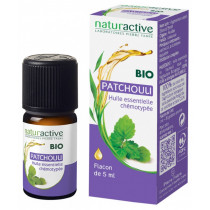Indications of organic Patchouli essential oil
Foot mycosis, ill-smelling sweaty feet, phlebotonic, skin anti-inflammatory, anti-irritant (eczema), toning & calming essential oil, anti-insects.
Botany information
Pogostemon cablin Botanical family: Lamiaceae Producing organ: leaves Chemotype: pathoulol, alpha-bulnesene, alpha-guaiene Origin: Indonesia, Sri-Lanka, India
Botany specifications
Originally from South-East Asia, the Patchouli plant arrived in Europe at the end of the 18th century. Its effect on insects was well-known amongst the merchants. Returning from his campaign in Egypt, Bonaparte brought back a load of precious silks and woollen fabric, which had been protected from moths by slipping patches of Patchouli between the fabric.
Use
Diffusion +, Bath +++, Massage +++, Orally +
Ambient setting: on its own or in a mixture by regular low heat evaporation.
Atmospheric diffusion: in a mixture from a diffuser by spraying.
Dermal application: diluting (5-15% maximum) in vegetable oil.
Orally: diluted with some vegetable oil - only after medical agreement. 1-2 drops 3 times per day.
Practical advice
Foot Massage- (fungus or bad odour): 10 drops of patchouli EO + 5 drops of lemongrass EO + 10 drops of tea-tree EO in 30ml of apricot kernel vegetable oil. 2 applications per day.
Bath-itchy dermatosis (itching): 15 drops of patchouli EO + 5 drops of geranium EO in 4 cap-fulls or 20 pressures of a neutral base. Pour into a warm bath, maximum 3 times per week.
Contraindication
Not recommended for pregnant or breast feeding women or children under 8 years of age. 1ml = 20 drops (approximately)




